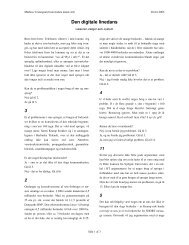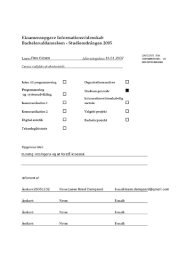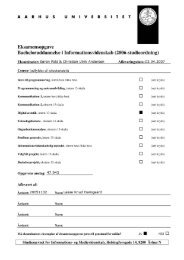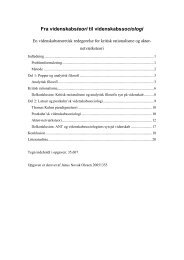Semiotics, Fashion and Cognition - Mathias Vestergaard Corp.
Semiotics, Fashion and Cognition - Mathias Vestergaard Corp.
Semiotics, Fashion and Cognition - Mathias Vestergaard Corp.
You also want an ePaper? Increase the reach of your titles
YUMPU automatically turns print PDFs into web optimized ePapers that Google loves.
<strong>Mathias</strong> <strong>Vestergaard</strong> Jakobsen <strong>Semiotics</strong>, <strong>Fashion</strong> an <strong>Cognition</strong> 2008-06-11<br />
shiny) while others require a bit more technical skill, but even if the language user is actually not<br />
able to distinguish wool from cotton, the magazine has still influenced her by pointing to the<br />
importance of making the distinction.<br />
<strong>Fashion</strong> magazines thus create an extension of the language, allowing for more precise<br />
categorizations than just “hat” <strong>and</strong> “sweater” – we learn that it is a “cashmere v-neck” <strong>and</strong> a<br />
“fedora”– just as a carpenter must be able to correctly categorize <strong>and</strong> label different kinds of<br />
screwdrivers <strong>and</strong> screws.<br />
Many of these distinctions seem to be image schematic in nature: they are recurrent patterns in our<br />
ordering activities (e.g. colors, surfaces, the slimness of a silhouette, the level of transparency in a<br />
fabric, the type of buttons) <strong>and</strong> they can be schematized. However, as the example with the Korean<br />
<strong>and</strong> English speaking babies showed, the fact that our daily language does not make use of these<br />
distinctions makes us forget them. And, since the fashion community language is (usually) learned<br />
at a much later stage of development than the acquisition of everyday language, these distinctions<br />
might seem less natural compared to over/under or tight-fit/loose-fit. However, once they have<br />
been learned, they are so readily available that most speakers find it natural. Reading that “Aviator<br />
sunglasses are the Learjets of style.” tells us that it is the shape of the sunglasses that matters<br />
(implicitly in opposition to an exact br<strong>and</strong> name or particular model). 9<br />
When perceiving an outfit or a single garment, the schematic distinctions in the fashion language<br />
extension, allows the perceiver to analyze the details, <strong>and</strong> in turn evoke many extra frames of<br />
experience. This also explains why someone with an interest in fashion <strong>and</strong> the distinctions<br />
available might find one outfit exceptional <strong>and</strong> another horrible, while someone else cannot really<br />
see the difference.<br />
Conclusion<br />
In his early essays Rol<strong>and</strong> Barthes’s view on fashion is described in terms of language. He treats the<br />
human use of clothing as an act of dressing both shaped by <strong>and</strong> shaping the shared system of how<br />
to dress. His later essays <strong>and</strong> The <strong>Fashion</strong> System, leaves the material clothing behind <strong>and</strong> focuses<br />
on the construction of fashion in the narrower sense. His point is that fashion is constructed<br />
through magazines as a semiological system of signifiers, <strong>and</strong> that these signifiers also point to the<br />
fashion itself as a universal signified.<br />
Reexamining Barthes’s theory in the light of a cognitive language tradition provides a fresh view.<br />
Clothing <strong>and</strong> fashion can still be seen as special type of language. Material clothing can incorporate<br />
elements from different prototypical outfits, e.g. a shoulder strap points to the male military<br />
uniform, whereas pink tulle points to the princess skirt. By mixing these elements in different ways,<br />
either by the designer in the sewn garment or by the wearer’s combination of different garments,<br />
the outfit will evoke certain cognitive frames in the viewer’s mind. Arguably, since the semantic<br />
meaning of the clothes is poor, most of the communication relies on the mental frames available in<br />
mind of the viewer.<br />
9 Example taken from July 2008 issue of Esquire, published by Hearst Magazines. Note also the simple<br />
metaphoric language linking pilot sunglasses to expensive private jet planes.<br />
Side 14 af 17








